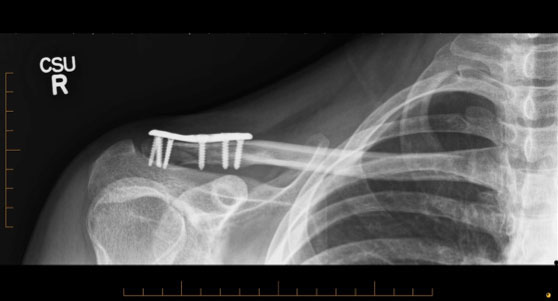
Collarbone Fractures in Racing Industry
Collarbone fractures are common injuries in jockeys and track workers who are involved in riding and training horses, according to Sydney orthopaedic surgeon Dr David Duckworth.
“A new surgical plate that I’ve developed for fractured collarbones is delivering great outcomes for these types of patients,” he said.
“I’ve recently used this fixing device in a 31-year-old track worker who sustained a fracture to the distal (outer) end of his collarbone while taking a colt out for his routine gallop.”
When the rider, Chris Harwood, pulled up past the finish line, the horse’s leg broke, throwing him forward three metres, landing in sand on his right shoulder.
In considerable pain and with a noticeable lump on his collarbone and a “floppy” arm, Chris was taken to the nearest emergency department where x-rays confirmed a displaced fracture on the distal (outer) end of his collarbone.
“As these types of fractures have a high chance of not healing, I chose to operate soon after seeing Chris to reduce and realign the fracture with a new surgical plate especially designed to treat these types of fractures,” Dr Duckworth said.

The new plate is smaller than other plates commonly used and has more options to screw the plate to the bone, which provides surgeons with greater precision in positioning the plate and stabilising the fracture, he said.
According to Dr Duckworth, patients fitted with the new plate are reporting faster healing times and better range of movement than people fitted with other types of fixing devices.
Immediately after the operation, while Chris still had some discomfort, he could feel an immediate improvement in his shoulder.
“I saw Chris 10 days after his operation and he was making good progress,” he said. “He was already starting to use his arm and shoulder on normal activities, like drinking cups of tea and typing on a keyboard,” he said.
Three months after the operation, Chris reports his shoulder is 95 per cent back to normal, and he is only experiencing the odd “niggle”.
He has taken up regular swimming, which has helped improve his range of movement, and he’s looking forward to returning to work in the next few weeks, riding some “quieter” horses to start with.
For specific advice regarding clavicle fractures, please book an appointment with Dr David Duckworth on (02) 9806 3333